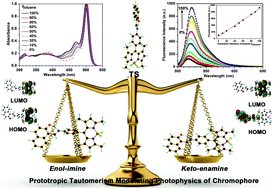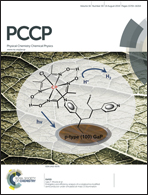Experimental and theoretical study of enol–keto prototropic tautomerism and photophysics of azomethine–BODIPY dyads†
Abstract
In this study we report about two novel azomethine–BODIPY dyads 1 and 2. The two dyads have been, respectively, synthesized by covalent tethering of tautomeric ortho-hydroxy aromatic azomethine moieties including N-salicylideneaniline (SA) and N-naphthlideneaniline (NA) to a BODIPY fluorophore. Both of the two dyads 1 and 2 show enol-imine (OH) structures dominating in the crystalline state. Dyad 1 in the enol state is the most stable form at room temperature in most media, while enol–keto prototropic tautomerism of the NA moiety in solution is preserved in dyad 2, which can be reversibly converted between enol and keto forms in the environment's polarity. Visible illumination of dyad 2 in the enol state excites selectively the BODIPY fragment and then deactivates radiatively by emitting green light in the form of fluorescence, while the emission intensity of 2 in the keto state is quenched on the basis of the proton-coupled photoinduced electron transfer (PCPET) mechanism. This allows large fluorescence modulation between the two states of dyad 2 and generates a novel tautomerisable fluorescent switch. Theoretical calculations including calculated energies, potential energy surfaces (PESs) and intrinsic reaction coordinate (IRC) analysis further support that the single proton transfer reaction from an enol form to a transition state (TS) and from the TS to a keto form for 2 is easier to occur than that for 1, which accounts for the fluorescence quenching of 2 in methanol. The agreement of the experimental results and theoretical calculations clearly suggests that fluorescent and tautomeric components can be paired within the same molecular skeleton and the proton tautomerization of the latter can be designed to regulate the emission of the former. In addition, preliminary experiments revealed that 1 can be potentially used as a simple on/off fluorescent chemosensor which exhibited higher selectivity for Cu2+ over other common cations.


 Please wait while we load your content...
Please wait while we load your content...